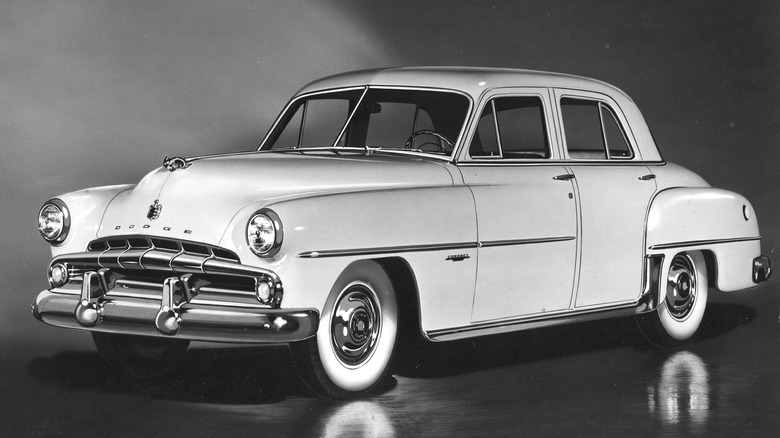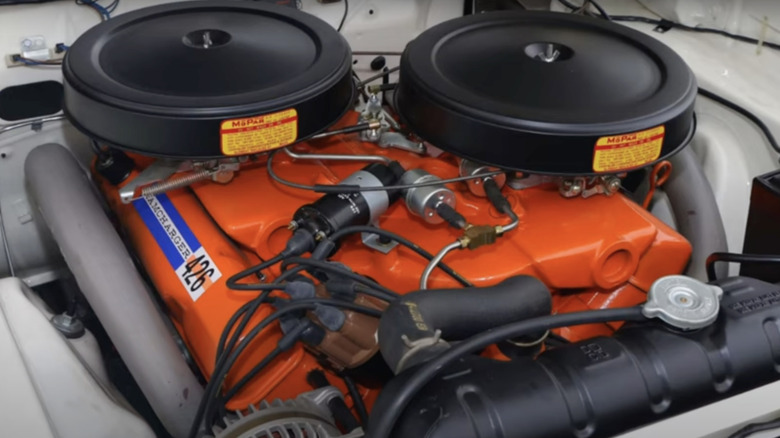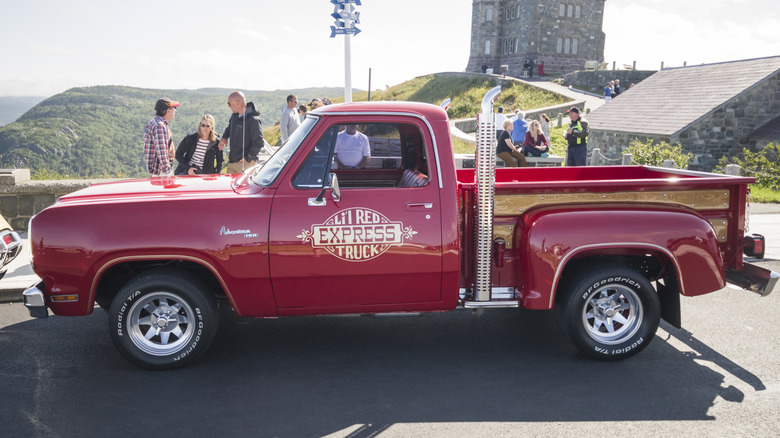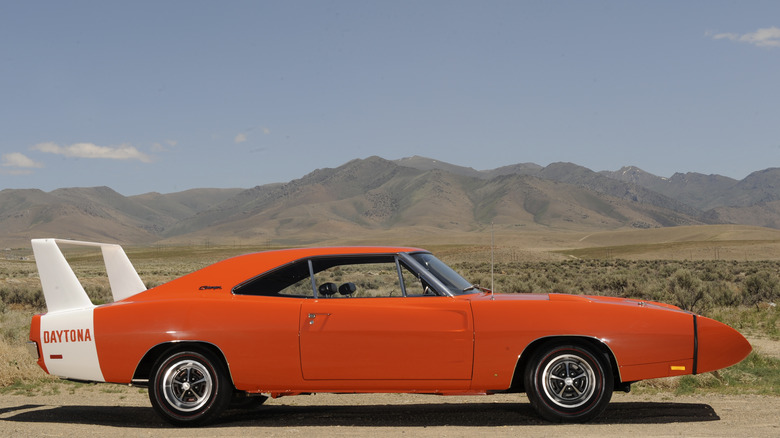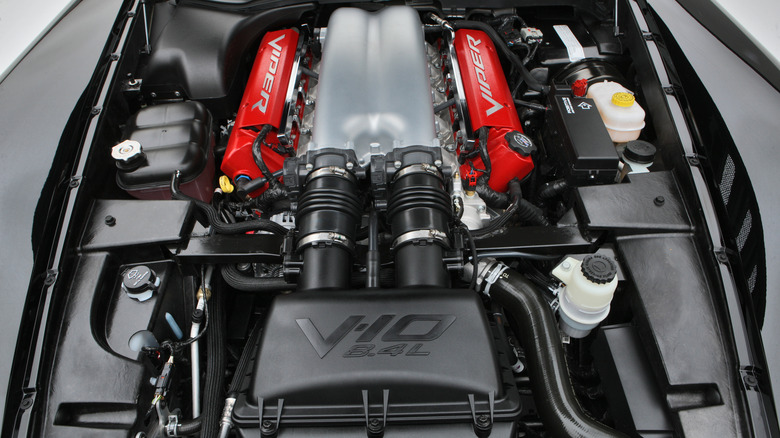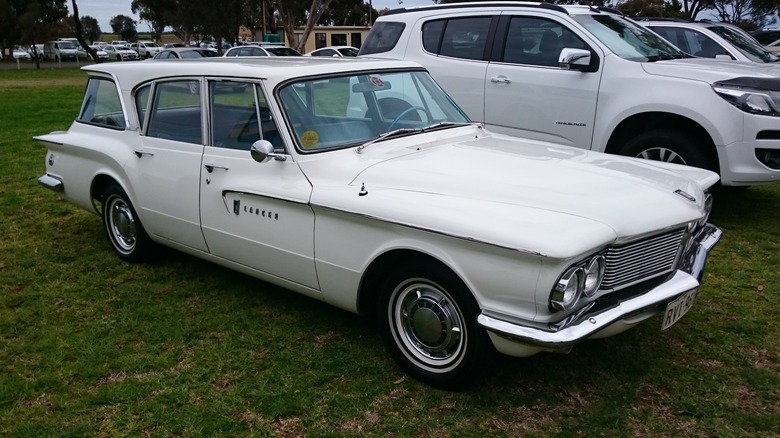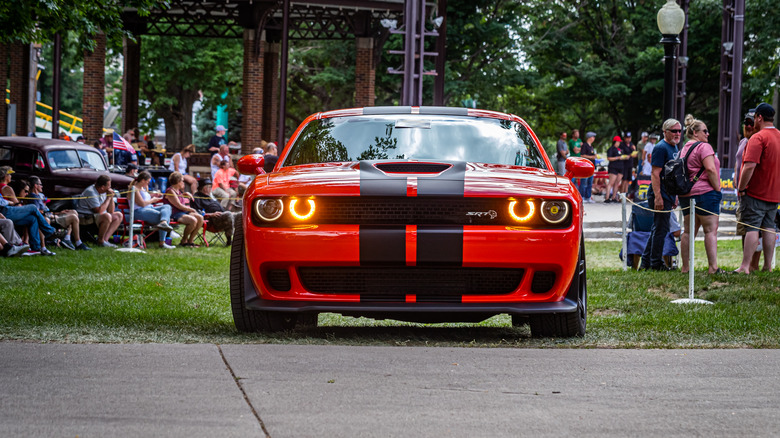6 Underrated Engines That Powered Dodge's Coolest Vehicles
Michigan natives John and Horace Dodge started a machine shop and bicycle-building business at the dawn of the 20th century. The two expanded to making parts for Oldsmobile, Northern, and Ford before building the first Dodge Brothers car in 1914. According to Dodge Garage, they built just 249 vehicles that first year, but by 1915, Dodge was the nation's third-biggest automaker.
By 1919, Dodge was selling 100,000 cars a year, but both brothers died during the 1920 flu epidemic. John and Horace's surviving wives sold the company five years later to an investment banker, who passed it on to Chrysler in 1928 for $170 million.
During World War II, Dodge pivoted to producing military equipment before resuming consumer car and truck production after Germany's 1945 surrender. From there, 1950 was a milestone year for Dodge: The automaker introduced its first hardtop coupe — the Coronet — and entered the NASCAR fray for the first time. In the nearly three-quarters of a century since, Dodge joined the muscle car party with asphalt-scorching monsters like the Charger and Daytona and helped welcome the first of a long-lived series of Chrysler slant six engines with the 1960 Dart.
Dodge also was a big player in introducing four-wheel drive to the truck-buying public when it introduced the Power Wagon in 1946. In the years since then, Dodge contributed many additional gems to the domestic vehicle market, several of which were powered by impressive engines that don't quite get the respect they deserve.
Ramcharger Max Wedge
The second-generation Mopar hemi V8 is a true legend of the auto industry. Benjamin Hunting of Driving Line called it "perhaps the most legendary motor of the muscle car era." The 426 Hemi began as a NASCAR engine in 1964, and was so dominant that the series instituted homologation requirements the next year, forcing the Hemi to market in 1966 models like the Coronet and Charger.
Often forgotten among the Hemi hysteria (Hemistera?) are the 413 and 426 cubic inch Max Wedge engines that first appeared in the 1962 Dart. The 413 Max Wedge could also be ordered in any Plymouth model that wasn't a station wagon, and the 1962-64 run of the Max Wedge served as a bridge between the 1951-58 Hemi, and the second-generation version that replaced the Max Wedge.
The Max Wedge got the back half of its name from the shape of the combustion chambers, echoing the Hemi's naming convention. Dodge Max Wedge engines were tagged with the "Ramcharger" label and could be ordered in the 330, 440, Polara, and Polara 500. The 426 Max Wedge was only available in 1963 and 1964, and slung the '64 Polara 500 from 0-60 mph in a remarkable 5.5 seconds.
Lil' Red Express 360 V8
While it may not be the largest or most powerful Dodge engine on paper, the LA series 360 cubic inch V8 lasted more than three decades under the hoods of Dodge trucks. It was first used in 1971 models, but the most intriguing application of the 360 was in the Lil' Red Express, a "muscle truck" that was only produced in 1978 and 1979. The LRE's 360 was a customized version of the E58 police V8, and was topped with a four-barrel carburetor. The 360 was also used in Chargers of the era, and also lent to Mopar partner Plymouth for use in the Roadrunner and Duster.
In the Lil' Red Express, Dodge avoided (dodged) the need for a catalytic converter by taking advantage of a weight loophole that exempted vehicles over 6,000 pounds. The stylish and powerful beast was also still permitted to run on leaded fuel, and had two vertical semi-truck style exhaust stacks that produced a thunderous 94 decibels inside the cabin at 110 mph, per Motor Trend. According to IAC acoustics, that is only marginally quieter than a jet taking off from about 1,000 feet away and enough to cause hearing damage in a few hours.
Charger Daytona 440 Magnum
The 1960s saw some space-age car designs aimed at enticing buyers with swooping lines and innovative features. One of the truly unique vehicles of the era was the 1969 Dodge Charger Daytona; a car that was built to woo NASCAR champion Richard Petty back from Ford.
At the time, stock car racing was restricted to production models with a run of more than 500 units, so Dodge built 503 Charger Daytonas. It had a pointed nose cone in place of a vertical grille and a 23-inch rear wing, and these aerodynamic touches helped make the Charger Daytona the first car to crack the 200 mph barrier in a NASCAR race. These aerodynamic touches could hardly get all the credit for that milestone: Two mighty engine options were the primary providers of its legendary speed.
The 426 hemi was under the hood of 70 of the 503 '69 Daytona models, and the rest got the Magnum 440 cubic inch V8. The 440 Magnum made 375 horsepower and 480 pound-feet of torque and hurled the Daytona from 0-60 mph in 5.6 seconds. The Charger Daytona's design and engines were carried over into the Plymouth Superbird in 1970; that car brought Petty back into the Mopar fold, and he won 18 races that year in the Superbird.
Viper V10
It might be a stretch to call the Dodge Viper's V10 engine "underrated," but it has certainly been overshadowed by many of its competitors since the Viper was unveiled as a concept car at the 1989 Detroit Motor Show, and returned to Motor City as a production model three years later. The sleek, wedge-shaped supercar was the brainchild of Chrysler president Bob Lutz, who wanted to build a car that could compete with the Shelby Cobra, Ferrari F40, and Acura NSX.
Chrysler had purchased Lamborghini in 1987, and the Viper's V10 was a collaborative effort between engineers from both companies. The first-gen Viper's engine displaced 8.0 liters, producing 400 horsepower and 465 pound-feet of torque. Power increased with updates in 1996 and 2003, but the fourth generation that appeared in 2008 had a new 8.4 liter V10 with variable valve timing, a redesigned cylinder head, and two throttle bodies.
These changes and the increased displacement gave the fourth-gen Viper astonishing power output numbers of 600 horsepower and 560 pound-feet of torque. Dodge announced it would drop the Viper in 2010, but reconsidered and updated it again in 2013. The 8.4 liter V-10 now made 640 horsepower and 600 pound-feet, and could go from 0-60 mph in 3.5 seconds, with a top speed of 200 mph.
Many special editions of the Viper were released during its quarter-century run, including five small-batch versions that ushered the model to the eternal scrapyard in 2017.
Hyper Pak 225 slant six
The Mopar family slant six engine earned a well-deserved place on SlashGear's list of the most reliable straight six engines in automotive history based on its 60-plus year reputation for solid performance. In our ranking of every version of the slant six, the one that took top honors was the Hyper-Pak 225, which debuted under the hood of the 1961 Dodge Lancer and Plymouth Valiant. The Hyper Pak added a long-tube ram air intake, four-barrel carburetor, and upgraded exhaust system to the stock 225 slant six.
These changes boosted horsepower from 145 to 196, and helped the Lancer get from 0-60 mph in 8.6 seconds. This was about four seconds quicker than the standard-issue 225, and according to Automobile Catalog, was roughly on par with that year's Ford Thunderbird — equipped with a 390 cubic inch V8. The Hyper Pak was also offered on the 170 cubic inch slant six, increasing the smaller engine's output to 182 horsepower.
Clifford Performance used to make an aftermarket version of the Hyper-Pak system, and in 2003, Motor Trend tested it on a 225, and measured 231 horsepower and 280 pound-feet of torque.
[Featured image by GTHP via Wikimedia Commons | Cropped and scaled | CC-BY 4.0]
6.2L V8 Hemi
Familiarity doesn't always breed contempt. Sometimes it just brings indifference. Dodge's 6.2 liter hemi V8 wowed car lovers when it debuted in the 2015 Challenger SRT Hellcat, but almost a decade later, it is sometimes taken for granted and lost in the sea of high-performance engines that have come to market since.
Car and Driver's Jared Gall tested the Hellcat, and wrote that its 707-horsepower engine "officially ushers in the age of unreason." He got the Hellcat from 0-60 mph in 3.6 seconds, and to 150 mph in an even 17 seconds. That equaled the pace of the 2015 Viper, which at the time was powered by an 8.4 liter V10.
Making the 6.2 liter Hemi's performance more impressive is the weight difference between Dodge's two pavement-burners. The 2015 SRT Hellcat weighed 4,488 pounds, and the Viper of the same vintage was more than half a ton lighter. The Hellcat's engine was also used in the Charger, Durango, and Ram 1500 pickup, and also lent to Jeep to be dropped in the Grand Cherokee. The ethanol-fueled SRT Demon's 6.2 liter hemi produced more than 1,000 horsepower, and generated a positively chiropractic two-plus Gs on its way from 0-60 mph in 1.66 seconds.
